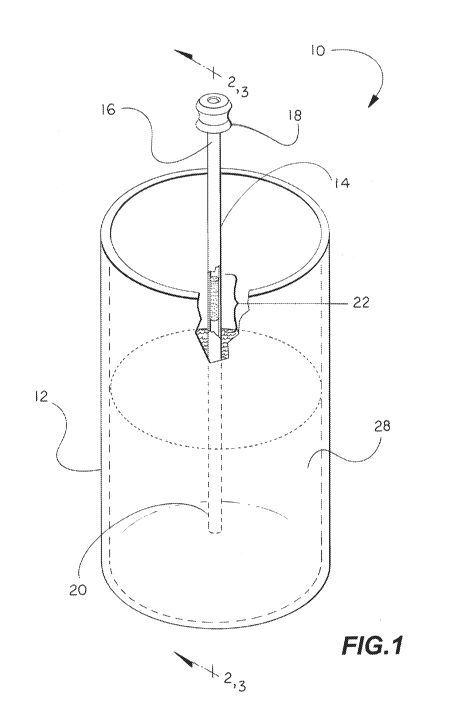Some of the information on this Web page has been provided by external sources. The Government of Canada is not responsible for the accuracy, reliability or currency of the information supplied by external sources. Users wishing to rely upon this information should consult directly with the source of the information. Content provided by external sources is not subject to official languages, privacy and accessibility requirements.
Any discrepancies in the text and image of the Claims and Abstract are due to differing posting times. Text of the Claims and Abstract are posted:
| (12) Patent Application: | (11) CA 3088387 |
|---|---|
| (54) English Title: | HICCUP RELIEVING APPARATUS |
| (54) French Title: | APPAREIL SOULAGEANT LE HOQUET |
| Status: | Examination Requested |
| (51) International Patent Classification (IPC): |
|
|---|---|
| (72) Inventors : |
|
| (73) Owners : |
|
| (71) Applicants : |
|
| (74) Agent: | GOWLING WLG (CANADA) LLP |
| (74) Associate agent: | |
| (45) Issued: | |
| (86) PCT Filing Date: | 2019-01-16 |
| (87) Open to Public Inspection: | 2019-07-25 |
| Examination requested: | 2023-12-22 |
| Availability of licence: | N/A |
| (25) Language of filing: | English |
| Patent Cooperation Treaty (PCT): | Yes |
|---|---|
| (86) PCT Filing Number: | PCT/US2019/013728 |
| (87) International Publication Number: | WO2019/143643 |
| (85) National Entry: | 2020-07-13 |
| (30) Application Priority Data: | ||||||
|---|---|---|---|---|---|---|
|
The hiccup relieving apparatus includes a tube with a first end having a mouthpiece, a second end for immersion in water or other potable liquid in a container, and an obstruction in the tube between the first end and the second end. The obstruction requires an adult user, using the mouthpiece, to produce a threshold suction of at least 20 cm of water before water can flow from the water in the water container, through the tube, through the mouthpiece, and to the user. The obstruction can take the form of a threshold valve in the tube, a sized orifice in the immersed end of the tube, or a wad of cellulosic material in the tube.
L'invention concerne un appareil soulageant le hoquet, comprenant un tube doté d'une première extrémité munie d'un embout buccal, d'une seconde extrémité destinée à être immergée dans de l'eau ou un autre liquide potable dans un récipient, et d'une obstruction dans le tube entre la première extrémité et la seconde extrémité. L'obstruction impose à un utilisateur adulte de produire, à l'aide de l'embout buccal, une aspiration seuil d'au moins 20 cm d'eau avant que de l'eau puisse s'écouler à partir de l'eau présente dans le récipient à eau, à travers le tube, à travers l'embout buccal, et jusqu'à l'utilisateur. L'obstruction peut prendre la forme d'un clapet à seuil dans le tube, d'un orifice calibré dans l'extrémité immergée du tube, ou d'un tampon de matériau cellulosique dans le tube.
Note: Claims are shown in the official language in which they were submitted.
Note: Descriptions are shown in the official language in which they were submitted.

For a clearer understanding of the status of the application/patent presented on this page, the site Disclaimer , as well as the definitions for Patent , Administrative Status , Maintenance Fee and Payment History should be consulted.
| Title | Date |
|---|---|
| Forecasted Issue Date | Unavailable |
| (86) PCT Filing Date | 2019-01-16 |
| (87) PCT Publication Date | 2019-07-25 |
| (85) National Entry | 2020-07-13 |
| Examination Requested | 2023-12-22 |
There is no abandonment history.
Last Payment of $100.00 was received on 2023-12-27
Upcoming maintenance fee amounts
| Description | Date | Amount |
|---|---|---|
| Next Payment if small entity fee | 2025-01-16 | $100.00 |
| Next Payment if standard fee | 2025-01-16 | $277.00 |
Note : If the full payment has not been received on or before the date indicated, a further fee may be required which may be one of the following
Patent fees are adjusted on the 1st of January every year. The amounts above are the current amounts if received by December 31 of the current year.
Please refer to the CIPO
Patent Fees
web page to see all current fee amounts.
| Fee Type | Anniversary Year | Due Date | Amount Paid | Paid Date |
|---|---|---|---|---|
| Application Fee | 2020-07-13 | $200.00 | 2020-07-13 | |
| Maintenance Fee - Application - New Act | 2 | 2021-01-18 | $50.00 | 2021-01-14 |
| Maintenance Fee - Application - New Act | 3 | 2022-01-17 | $50.00 | 2022-01-14 |
| Maintenance Fee - Application - New Act | 4 | 2023-01-16 | $50.00 | 2023-01-13 |
| Request for Examination | 2024-01-16 | $408.00 | 2023-12-22 | |
| Maintenance Fee - Application - New Act | 5 | 2024-01-16 | $100.00 | 2023-12-27 |
Note: Records showing the ownership history in alphabetical order.
| Current Owners on Record |
|---|
| THE BOARD OF REGENTS OF THE UNIVERSITY OF TEXAS SYSTEM |
| Past Owners on Record |
|---|
| None |